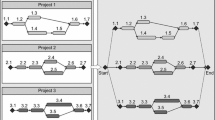Abstract
In this paper, we propose a new dataset for the resource-constrained multi-project scheduling problem and evaluate the performance of multi-project extensions of the single-project schedule generation schemes. This manuscript contributes to the existing research in three ways. First, we provide an overview of existing benchmark datasets and classify the multi-project literature based on the type of datasets that are used in these studies. Furthermore, we evaluate the existing summary measures that are used to classify instances and provide adaptations to the data generation procedure of Browning and Yassine (J Scheduling 13(2):143-161, 2010a). With this adapted generator we propose a new dataset that is complimentary to the existing ones. Second, we propose decoupled versions of the single-project scheduling schemes, building on insights from the existing literature. A computational experiment shows that the decoupled variants outperform the existing priority rule heuristics and that the best priority rules differ for the two objective functions under study. Furthermore, we analyse the effect of the different parameters on the performance of the heuristics. Third, we implement a genetic algorithm that incorporates specific multi-project operators and test it on all datasets. The experiment shows that the new datasets are challenging and provide opportunities for future research.








Similar content being viewed by others
Notes
The instances in each of our datasets have the same number of activities, so all projects are tied for the MAXACT and MINACT rules. Because we set MINCP as tie breaker, MINACT and MAXACT are equivalent to MINCP in this case. Therefore, we omit these rules here from the discussion.
References
Adhau, S., Mittal, M., & Mittal, A. (2012). A multi-agent system for distributed multi-project scheduling: An auction-based negotiation approach. Engineering Applications of Artificial Intelligence, 25(8), 1738–1751.
Adhau, S., Mittal, M., & Mittal, A. (2013). A multi-agent system for decentralized multi-project scheduling with resource transfers. International Journal of Production Economics, 146(2), 646–661.
Asta, S., Karapetyan, D., Kheiri, A., Özcan, E., & Parkes, A. J. (2016). Combining monte-carlo and hyper-heuristic methods for the multi-mode resource-constrained multi-project scheduling problem. Information Sciences, 373, 476–498.
Beşikci, U., Bilge, Ü., & Ulusoy, G. (2013). Resource dedication problem in a multi-project environment. Flexible Services and Manufacturing Journal, 25(1–2), 206–229.
Beşikci, U., Bilge, Ü., & Ulusoy, G. (2015). Multi-mode resource constrained multi-project scheduling and resource portfolio problem. European Journal of Operational Research, 240(1), 22–31.
Browning, T. R., & Yassine, A. A. (2010a). A random generator of resource-constrained multi-project network problems. Journal of Scheduling, 13(2), 143–161.
Browning, T. R., & Yassine, A. A. (2010b). Resource-constrained multi-project scheduling: Priority rule performance revisited. International Journal of Production Economics, 126(2), 212–228.
Chakrabortty, R. K., Sarker, R. A., & Essam, D. L. (2017). Resource constrained multi-project scheduling: A priority rule based evolutionary local search approach. In G. Leu, H. K. Singh, & S. Elsayed (Eds.), Intelligent and evolutionary systems (pp. 75–86). Canberra, Australia: Springer.
Chen, P.-H., & Shahandashti, S. M. (2009). Hybrid of genetic algorithm and simulated annealing for multiple project scheduling with multiple resource constraints. Automation in Construction, 18(4), 434–443.
Chiu, H. N., & Tsai, D. M. (2002). An efficient search procedure for the resource-constrained multi-project scheduling problem with discounted cash flows. Construction Management and Economics, 20(1), 55–66.
Confessore, G., Giordani, S., & Rismondo, S. (2007). A market-based multi-agent system model for decentralized multi-project scheduling. Annals of Operations Research, 150(1), 115–135.
Davis, E. W. (1975). Project network summary measures constrained-resource scheduling. AIIE Transactions, 7(2), 132–142.
Deckro, R. F., Winkofsky, E., Hebert, J. E., & Gagnon, R. (1991). A decomposition approach to multi-project scheduling. European Journal of Operational Research, 51(1), 110–118.
Demeulemeester, E., Vanhoucke, M., & Herroelen, W. (2003). Rangen: A random network generator for activity-on-the-node networks. Journal of scheduling, 6(1), 17–38.
Dumond, J., & Mabert, V. A. (1988). Evaluating project scheduling and due date assignment procedures: An experimental analysis. Management Science, 34(1), 101–118.
Elmaghraby, S. E. (1977). Activity networks: Project planning and control by network models. New York: Wiley.
Geiger, M. J. (2017). A multi-threaded local search algorithm and computer implementation for the multi-mode, resource-constrained multi-project scheduling problem. European Journal of Operational Research, 256(3), 729–741.
Gonçalves, J. F., Mendes, J. J., & Resende, M. G. (2008). A genetic algorithm for the resource constrained multi-project scheduling problem. European Journal of Operational Research, 189(3), 1171–1190.
Hartmann, S. (1998). A competitive genetic algorithm for resource-constrained project scheduling. Naval Research Logistics (NRL), 45(7), 733–750.
Hartmann, S., & Briskorn, D. (2010). A survey of variants and extensions of the resource-constrained project scheduling problem. European Journal of operational research, 207(1), 1–14.
Homberger, J. (2007). A multi-agent system for the decentralized resource-constrained multi-project scheduling problem. International Transactions in Operational Research, 14(6), 565–589.
Homberger, J. (2012). A (\(\mu \), \(\lambda \))-coordination mechanism for agent-based multi-project scheduling. OR Spectrum, 34(1), 107–132.
Kolisch, R., & Sprecher, A. (1997). Psplib-a project scheduling problem library: Or software-orsep operations research software exchange program. European Journal of Operational Research, 96(1), 205–216.
Krüger, D., & Scholl, A. (2009). A heuristic solution framework for the resource constrained (multi-) project scheduling problem with sequence-dependent transfer times. European Journal of Operational Research, 197(2), 492–508.
Krüger, D., & Scholl, A. (2010). Managing and modelling general resource transfers in (multi-) project scheduling. OR Spectrum, 32(2), 369–394.
Kumanan, S., Jose, G. J., & Raja, K. (2006). Multi-project scheduling using an heuristic and a genetic algorithm. The International Journal of Advanced Manufacturing Technology, 31(3–4), 360–366.
Kurtulus, I. (1985). Multiproject scheduling: Analysis of scheduling strategies under unequal delay penalties. Journal of Operations Management, 5(3), 291–307.
Kurtulus, I., & Davis, E. (1982). Multi-project scheduling: Categorization of heuristic rules performance. Management Science, 28(2), 161–172.
Lawrence, S. R., & Morton, T. E. (1993). Resource-constrained multi-project scheduling with tardy costs: Comparing myopic, bottleneck, and resource pricing heuristics. European Journal of Operational Research, 64(2), 168–187.
Lee, Y.-H., Kumara, S. R., & Chatterjee, K. (2003). Multiagent based dynamic resource scheduling for distributed multiple projects using a market mechanism. Journal of Intelligent Manufacturing, 14(5), 471–484.
Liberatore, M. J., & Pollack-Johnson, B. (2003). Factors influencing the usage and selection of project management software. IEEE transactions on Engineering Management, 50(2), 164–174.
Lova, A., Maroto, C., & Tormos, P. (2000). A multicriteria heuristic method to improve resource allocation in multiproject scheduling. European Journal of Operational Research, 127(2), 408–424.
Lova, A., & Tormos, P. (2001). Analysis of scheduling schemes and heuristic rules performance in resource-constrained multiproject scheduling. Annals of Operations Research, 102(1–4), 263–286.
Maroto, C., Tormos, P., & Lova, A. (1999). The evolution of software quality in project scheduling. In J. Weglarz (Ed.), Project scheduling (pp. 239–259). Boston, MA: Springer.
Mittal, M., & Kanda, A. (2009). Two-phase heuristics for scheduling of multiple projects. International Journal of Operational Research, 4(2), 159–177.
Payne, J. H. (1995). Management of multiple simultaneous projects: A state-of-the-art review. International Journal of Project Management, 13(3), 163–168.
Pérez, E., Posada, M., & Lorenzana, A. (2016). Taking advantage of solving the resource constrained multi-project scheduling problems using multi-modal genetic algorithms. Soft Computing, 20(5), 1879–1896.
Singh, A. (2014). Resource constrained multi-project scheduling with priority rules and analytic hierarchy process. Procedia Engineering, 69, 725–734.
Song, W., Kang, D., Zhang, J., & Xi, H. (2017). A multi-unit combinatorial auction based approach for decentralized multi-project scheduling. Autonomous Agents and Multi-agent Systems, 31(6), 1548–1577.
Toffolo, T. A., Santos, H. G., Carvalho, M. A., & Soares, J. A. (2016). An integer programming approach to the multimode resource-constrained multiproject scheduling problem. Journal of Scheduling, 19(3), 295–307.
Vanhoucke, M., Coelho, J., Debels, D., Maenhout, B., & Tavares, L. V. (2008). An evaluation of the adequacy of project network generators with systematically sampled networks. European Journal of Operational Research, 187(2), 511–524.
Vázquez, E. P., Calvo, M. P., & Ordóñez, P. M. (2015). Learning process on priority rules to solve the RCMPSP. Journal of Intelligent Manufacturing, 26(1), 123–138.
Vercellis, C. (1994). Constrained multi-project plannings problems: A Lagrangean decomposition approach. European Journal of Operational Research, 78(2), 267–275.
Wang, X., Chen, Q., Mao, N., Chen, X., & Li, Z. (2015). Proactive approach for stochastic rcmpsp based on multi-priority rule combinations. International Journal of Production Research, 53(4), 1098–1110.
Wang, Y., He, Z., Kerkhove, L.-P., & Vanhoucke, M. (2017). On the performance of priority rules for the stochastic resource constrained multi-project scheduling problem. Computers and Industrial Engineering, 114, 223–234.
Wauters, T., Kinable, J., Smet, P., Vancroonenburg, W., Berghe, G. V., & Verstichel, J. (2016). The multi-mode resource-constrained multi-project scheduling problem. Journal of Scheduling, 19(3), 271–283.
Wauters, T., Verbeeck, K., De Causmaecker, P., & Berghe, G. V. (2015). A learning-based optimization approach to multi-project scheduling. Journal of Scheduling, 18(1), 61–74.
Yang, K.-K., & Sum, C.-C. (1993). A comparison of resource allocation and activity scheduling rules in a dynamic multi-project environment. Journal of Operations Management, 11(2), 207–218.
Yang, K.-K., & Sum, C.-C. (1997). An evaluation of due date, resource allocation, project release, and activity scheduling rules in a multiproject environment. European Journal of Operational Research, 103(1), 139–154.
Zheng, Z., Shumin, L., Ze, G., & Yueni, Z. (2013). Resource-constraint multi-project scheduling with priorities and uncertain activity durations. International Journal of Computational Intelligence Systems, 6(3), 530–547.
Acknowledgements
We acknowledge the support provided by the Special Research Fund (BOF Grant No. DOC014-18 Van Eynde) and the National Bank of Belgium for providing the first author with a pre-doctoral fellowship. The computational resources (Stevin Supercomputer Infrastructure) and services used in this work were provided by the VSC (Flemish Supercomputer Center), funded by Ghent University, FWO and the Flemish Government department EWI.
Author information
Authors and Affiliations
Corresponding author
Additional information
Publisher's Note
Springer Nature remains neutral with regard to jurisdictional claims in published maps and institutional affiliations.
Appendix: Summary measures
Appendix: Summary measures
Measure | Formula | Notes |
|---|---|---|
Network measures | ||
C | \(\frac{A' - A'_\mathrm{min}}{A'_\mathrm{max^*}-A'_\mathrm{min}}\) | |
NC | \(\frac{A^n_j}{|I_j|+2}\) | The average number of non-redundant arcs per node, including dummies\({}^\mathrm{a}\) |
NPL | \(\frac{|I_j|}{L_j}\) | The average number of activities in parallel |
OS | \(\frac{A^r_j}{|I_j|*(|I_j|-1)/2}\) | The ratio of the number of arcs (excluding dummies) and the theoretical number of arcs\({}^\mathrm{b}\) |
SP | \(\frac{L_j - 1}{|I_j|-1}\) | The ratio of the longest chain in the network and the total number of activities |
Resource measures | ||
ARLF | \( \frac{1}{CP_{j}}\sum _{t = r_j}^{r_j+CP_{j}}\sum _{i \in I_j}\sum _{k \in H_{ij}}Z_{ijt}X_{ijt}\left( \frac{r_{ijk}}{|H_{ij}|} \right) \) | |
AUF | \(\frac{1}{S} \sum _{s=1}^S \frac{W_{sk}}{l_sR_k}\) | S is the number of intervals, \(W_{sk}\) the total resource demand for resource k in interval s and \(l_s\) the length of the interval |
Load | \(\frac{R_k}{|J|\cdot d_k}\) | \(d_k\) is the duration of an activity with resource demand for type k |
MAUF | \(\frac{1}{M_{ES}} \sum _{s=min_{j\in J}r_j}^{M_{ES}} \frac{W_{sk}}{l_sR_k}\) | Similar to AUF, with \(l_s = 1\) |
\(\sigma ^2_\mathrm{UF}\) | \( \frac{\sum _{k\in K} (\text {UF} - \text {UF}_k)^2}{|K|}\) | |
MUF | \(\max _{k\in K} \frac{\sum _{j\in J}\sum _{i\in I_j} r_{ijk}d_{ij}}{R_k M_{ES}}\) | The ratio of the earliest start schedule resource requirements and the available resources |
NARLF | \(\frac{1}{|J| * CP_\mathrm{max}}\sum _{j\in J}\sum _{t = r_j}^{r_j+CP_{j}}\sum _{i \in I_j}\sum _{k \in H_{ij}} Z_{ijt}X_{ijt}\left( \frac{r_{ijk}}{|H_{ij}|} \right) \) | |
NARLF\('\) | \(\frac{1}{|J| * CP_\mathrm{max}}\sum _{j\in J}\sum _{t = r_j}^{r_j+CP_{j}}\sum _{i \in I_j}\sum _{k \in H_{ij}} Z'_{t}X_{ijt}\left( \frac{r_{ijk}}{|H_{ij}|} \right) \) | |
RC | \(\frac{1}{|K|}\sum _{k\in K}\frac{\overline{r_k}}{R_k}\) | Where \(\overline{r_k}\) is the average resource requirement, when it is required by an activity |
RF | \(\frac{\sum _{j\in J}\sum _{i\in I_j} |H_{ij}|}{|K|\sum _{j\in J}|I_j|}\) | The average percentage of resource types that an activity requires |
RS | \(\frac{R_k - r_k^\mathrm{min}}{r^\mathrm{max}_k - r_k^\mathrm{min}}\) | The resource strength. \(r_k^\mathrm{min}\) is the maximum demand for resource k over all activities, \(r_k^\mathrm{max}\) the peak demand for type k in the unconstrained earliest start schedule |
Rights and permissions
About this article
Cite this article
Van Eynde, R., Vanhoucke, M. Resource-constrained multi-project scheduling: benchmark datasets and decoupled scheduling. J Sched 23, 301–325 (2020). https://doi.org/10.1007/s10951-020-00651-w
Published:
Issue Date:
DOI: https://doi.org/10.1007/s10951-020-00651-w




